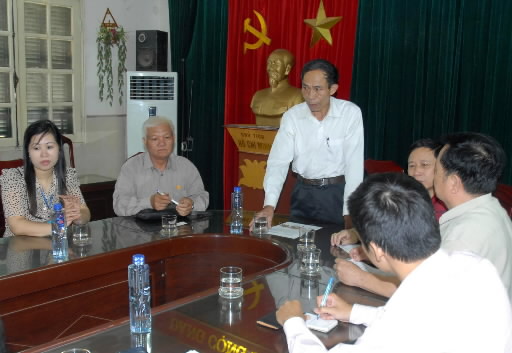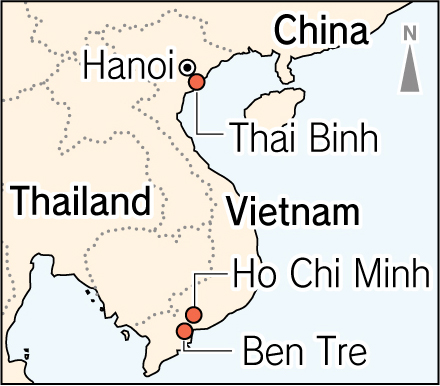Vietnam: 50 years after the use of defoliants, Part 1: Walking the affected areas, Article 5
Jul. 12, 2012
Article 5: Long path to obtaining aid
U.S. yet to acknowledge responsibility
by Takamasa Kyoren, Staff Writer
Most victims rely on their families
August 10, 2011 marked fifty years since the United States military began using defoliants in the Vietnam War. “We will ask the U.S. government to take responsibility for the environmental destruction and people’s health problems,” said Nguyen Thi Doan, vice president of Vietnam, in remarks at a ceremony held that day by the Vietnam Association for Victims of Agent Orange/Dioxin (VAVA) in Hanoi.
Claiming that it is unclear whether illnesses or disabilities are connected to the use of defoliants in Vietnam, the U.S. has not acknowledged its responsibility for any harm defoliants caused. The statement by Vice President Nguyen demonstrated that the issue remains unresolved 30 years after the end of the war.
In an effort to obtain aid for the victims of defoliants, Dr. Nguyen Thi Ngoc Phuong, 68, former director of Tu Du Hospital in Ho Chi Minh City, has testified before the U.S. Congress. “The large number of children born with abnormalities in areas where defoliants were sprayed has been confirmed by researchers, including Americans,” she said. “The U.S. does not acknowledge its responsibility because doing so will damage its reputation as a ‘nation of human rights.’” Once the U.S. acknowledges its responsibility, it will be liable for a huge amount of compensation.
Many researchers in Vietnam, Japan and the West began warning of the hazards of defoliants during the war. Nevertheless aid was not provided to victims. One factor behind this was the delicate relationship between Vietnam and the U.S. after the war.
Priority on economic development
The economic sanctions imposed on North Vietnam by the U.S. in 1964 remained in place following the unification of North and South Vietnam. Meanwhile, even after expelling U.S. forces, while it was at war Vietnam was isolated in the international community. And on the economic front, Vietnam was left behind by Thailand and other neighboring countries. In 1986 Vietnam introduced a market economy and rushed to improve its relations with the U.S.
While the U.S. swept inhumane acts committed during the war under the carpet, Vietnam wanted to avoid upsetting the economic superpower. After the normalization of diplomatic relations in 1995, neither country raised the issue of aid for the victims of defoliants.
Le Van Hoai, 67, lives on the outskirts of Ben Tre in southern Vietnam where there was fierce fighting. “I have suffered both disease and poverty,” he said. Around 1970 he was a member of a garrison force at a U.S. base on the outskirts of town. Of his five children born after he returned home (now ranging in age from 27 to 39), three have brain damage or other physical disabilities. Four years ago the three of them began receiving aid from the government totaling about 1.5 million dong (about 6,000) per month.
Case thrown out by U.S. Supreme Court
Against the background of its economic growth, around 2000 Vietnam began to pursue U.S. responsibility more strenuously. In order to file a suit for damages against U.S. chemical companies that had manufactured defoliants, victims and former government officials formed VAVA in 2003. Representatives of the organization filed a lawsuit in 2004, but in 2009 it was thrown out by the U.S. Supreme Court. “Meanwhile support for the victims is urgently needed,” said Nguyen Minh Y, 71, director of VAVA’s External Relations Department.
VAVA has branches in all 58 provinces of Vietnam and provides rehabilitation and day care services for victims. In 2011 a “detoxification center” was established in Thai Binh in the northern part of the country. Patients who suffer from numbness in their arms and legs and skin diseases do exercises and take sauna baths. “So far about 400 people have visited the facility, and the treatments are proving effective,” said Ho Sy Hai, vice chairman of the Thai Binh branch of VAVA.
But most of the victims have no one but their families to rely on. “There is so much to do, but money is tight, and the public has little interest,” said Mr. Nguyen. The path to obtaining aid is long and steep.
Government aid for victims of defoliants
According to the Vietnam Association for Victims of Agent Orange/Dioxin (VAVA), the system to provide government aid has been put in place since 2000. Currently some former military personnel and their children receive between 400,000 and 1.8 million dong (approximately 20 to 90 dollars) per month depending on the severity of their disabilities. In order to receive aid, applicants must demonstrate that they were in an area where defoliants were sprayed or that there are many disabilities among their relatives. According to VAVA, civilians are not entitled to receive government aid.
(Originally published on June 23, 2012)









